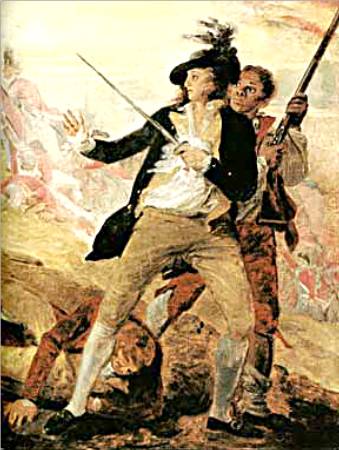
A BLACK REVOLUTIONARY SOLDIER
PETER SALEM: A BLACK INNOVATOR
Peter Salem, a black revolutionary soldier, was freed by his master so he could enlist in the Massachusetts Minutemen, is the. In spite of the unlimited hardships placed on slaves in the 17th and 18 centuries, many rose above them to make great contributions to the growth of the new nation. America: Discover Peter Salem’s contribution below.

THE PAINTING: BATTLE OF BUNKER HILL
Below: Take a look at a painting made by an artist. It focuses on Thomas Grosvenor, a British Army Officer, as the subject of the painting. It was not Peter, even though he was the hero. Salem fought with his company in the Battle of Bunker Hill. According to Samuel Swett, who chronicled the battle, Salem mortally wounded British Marine Major John Pitcairn who died from a musket shot.
PICTURE OF PETER AND GROSVENOR

Peter Salem: Unrecognized Grandeur
The man holding the sword is Thomas Grosvenor. He is not the hero. This writer views this as an example of how the contributions of blacks were demeaned or erased.
COMMENT OF A READER
“The man who was the hero of the moment was placed behind the man with a sword, who did not fell the enemy….Salem did.“
But Grosvenor became the subject of the painting, unless I am missing something about his importance to the event. From the entry we read, it would seem that Salem was the hero of the moment, but is given a secondary place in the painting.“
RESPONSE TO COMMENT
“I agree with you … (Salem was the hero) but the painting was done in the late 18th century (1787) when slavery was still “live and well” in America. The artist obviously felt he could not bestow that kind of honor on an ex-slave.
As the article states, in 1775, President Washington was not allowing African Americans to fight in the Union Army. It was only in 1783 when he allowed that to happen. Also, most of American society believed that “the slave always walked behind his master.” The picture typifies that thinking, while still trying to give credit to the ex-slave.
You are very perceptive! Thanks.“
PETER WAS A HERO
Additional Information: I believe the link below leads to clarification by another writer of the painting in the article on Peter Salem … please read it. The clarification reveals the painting did not depict Peter Salem at all, but a servant of Grosvenor.
AMERICA DISREGARDED A BLACK REVOLUTIONARY SOLDIER
Again I repeat … “we are what we believe!” The great part about all of this is … we can change what we believe! That change starts with self-analysis — “An independent, methodical attempt to study and comprehend one’s own personality, emotions, and behavior.” If you don’t like what you see, work to change it. If you like what you see, ask yourself if what you see is how you would like others to treat you. Lying or self-justification are key elements of thought that have to be removed, if change is to occur.
